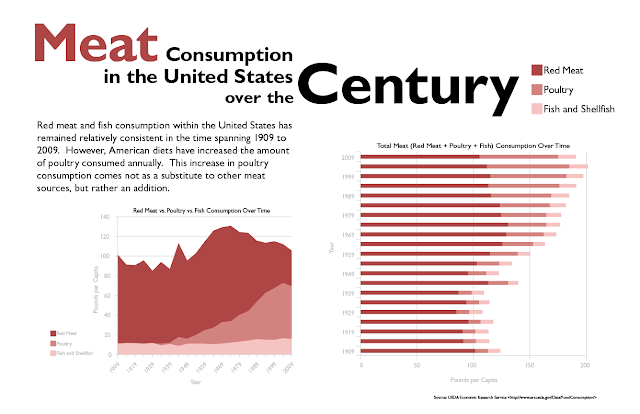Friday, March 30, 2012
Thursday, March 29, 2012
Wednesday, March 28, 2012
Tuesday, March 27, 2012
Monday, March 26, 2012
Thursday, March 22, 2012
Tuesday, March 20, 2012
Monday, March 19, 2012
Thursday, March 15, 2012
Wednesday, March 14, 2012
Tuesday, March 13, 2012
Monday, March 12, 2012
Now I'm Back From Outer Space
Monday, March 5, 2012
Information Design Examples
Image 1: This
diagram serves as a visual aide for the example of an exchange between an oil
refinery and an oil pipeline company in regards to transaction-specific
investments and their effects upon vertical integration. The design utilizes natural coloring
that quickly translates to the viewer.
However, there is an inconsistent style among the various items depicted
in the diagram leading to an appearance of clipart quickly joined together. There is no guide to lead the viewer
through the diagram in order to more clearly understand the relationship
between the refinery and the pipeline company. This diagram helps the reader to more clearly understand the
premise of the example written about within the text, but lends little
information for clarifying further detail discussed within the text. The relationship amongst the tanker
ship, refinery, tanker truck, pipeline, and oil field is ambiguous.
 Image 2: In
this graphic, the idea of corporate diversification is explained. It explains that there are three types
of corporate diversification, each with subsets. The graphics beside the short descriptions are to clarify
the concepts of each type of diversification. This figure nicely separates itself from the other text
creating a contrast between layers.
The example uses simplified shapes and lines to convey the various
relationships between businesses within a corporation. It is clear that the several lines
linking together E and F as well as K, L, M, and N show businesses that are
considerably linked together. The relationships
among Q, R, S, and T are obviously still linked, but not as closely and in
different ways between each business.
The businesses of W, X, Y, and Z are obviously not related. This figure quickly condenses the
concepts presented into a visual language that aides in the reader’s
understanding of the material.
While scale is addressed in the relationship between E and F, it is not
immediate due to the distance between the two circles connected with the three
lines. A greater difference in
scale could make this relationship easier to understand.
Image 2: In
this graphic, the idea of corporate diversification is explained. It explains that there are three types
of corporate diversification, each with subsets. The graphics beside the short descriptions are to clarify
the concepts of each type of diversification. This figure nicely separates itself from the other text
creating a contrast between layers.
The example uses simplified shapes and lines to convey the various
relationships between businesses within a corporation. It is clear that the several lines
linking together E and F as well as K, L, M, and N show businesses that are
considerably linked together. The relationships
among Q, R, S, and T are obviously still linked, but not as closely and in
different ways between each business.
The businesses of W, X, Y, and Z are obviously not related. This figure quickly condenses the
concepts presented into a visual language that aides in the reader’s
understanding of the material.
While scale is addressed in the relationship between E and F, it is not
immediate due to the distance between the two circles connected with the three
lines. A greater difference in
scale could make this relationship easier to understand. Image 3: This
figure is a diagram indicating shared activities among three businesses within
a corporation. It indicates that
all three share technology development.
Business C utilizes different product design and manufacturing processes
than do businesses A and B. All
three share the same marketing. Business
A has a different distribution channel.
All three businesses utilize the same service. This diagram shows that different businesses within the same
company can share aspects of the supply chain at different points in the
business development cycle.
However, without the context of the reading, the diagram would hold
little meaning. It is unclear
exactly what A, B, and C are from the diagram itself. The emphasis of the diagram is on the movement along the
supply chain based upon the color and weight of the arrows. In context, the graphic helps to
clarify the supply chain relationships among three businesses within a
corporation. However, more could
be done to bring clarity to this diagram through added detail.
Image 3: This
figure is a diagram indicating shared activities among three businesses within
a corporation. It indicates that
all three share technology development.
Business C utilizes different product design and manufacturing processes
than do businesses A and B. All
three share the same marketing. Business
A has a different distribution channel.
All three businesses utilize the same service. This diagram shows that different businesses within the same
company can share aspects of the supply chain at different points in the
business development cycle.
However, without the context of the reading, the diagram would hold
little meaning. It is unclear
exactly what A, B, and C are from the diagram itself. The emphasis of the diagram is on the movement along the
supply chain based upon the color and weight of the arrows. In context, the graphic helps to
clarify the supply chain relationships among three businesses within a
corporation. However, more could
be done to bring clarity to this diagram through added detail.
Barney,
Jay B., and William S. Hesterly. Strategic
Management and Competitive Advantage: Concepts and Cases. Upper Saddle
River, NJ: Pearson/Prentice Hall, 2008. Print.
Subscribe to:
Posts (Atom)






























